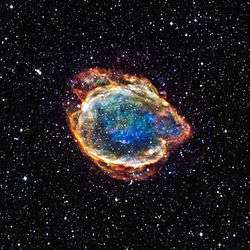Carbon detonation
Carbon detonation is the violent reignition of thermonuclear fusion in a white dwarf, which produces a Type Ia supernova. A white dwarf undergoes carbon detonation only if it has a binary star companion, be it a normal star or another white dwarf, close enough for the dwarf star to siphon sufficient amounts of matter onto itself, the siphoned matter having been expelled during the process of the companion's own late stage stellar evolution.
If the companion supplies enough matter to the dead star, the white dwarf's internal pressure and temperature will rise high enough to fuse the previously unfusable carbon in the white dwarf's core. Carbon detonation generally occurs when the accreted matter pushes the white dwarf's mass close to the Chandrasekhar limit of roughly 1.4 solar masses. The same happens when two white dwarfs collide and the mass of the remnant is also over the Chandrasekhar limit.
While heat is released by the fusion reactions, pressure initially is due almost entirely to electron degeneracy pressure rather than thermal energy and thus does not increase much, inhibiting expansion of the star (until too late) and allowing temperature and thus the rate of fusion to increase dramatically in a runaway process. The resumption of fusion spreads outward in a series of uneven, expanding "bubbles" exhibiting Rayleigh–Taylor instability.[1] Within the fusion area, the increase in heat with unchanged volume results in an exponentially rapid increase in the rate of fusion – a sort of supercritical event as thermal pressure increases boundlessly. With no hydrostatic equilibrium possible, this triggers a "thermonuclear flame," and an explosive eruption through the dwarf star's surface that completely disrupts it, seen as a Ia supernova.
This process, of a volume supported by electron degeneracy pressure instead of thermal pressure gradually reaching conditions capable of igniting runaway fusion, is also found in a less dramatic form in a helium flash in the core of a sufficiently massive red giant star.
See also
- Nuclear fusion
- Helium flash, a similar (although less cataclysmic) sudden initiation of fusion

